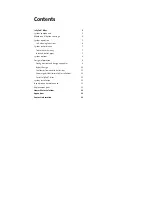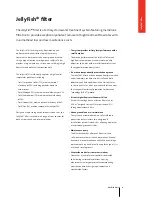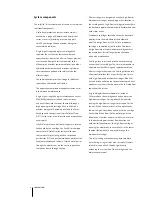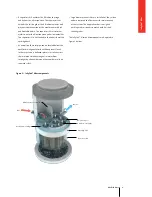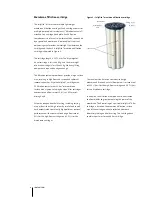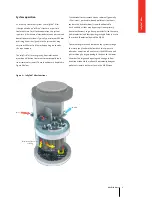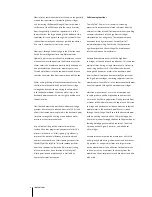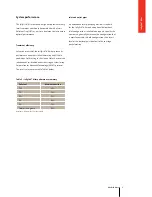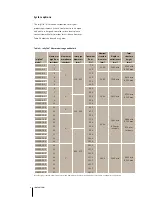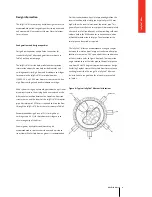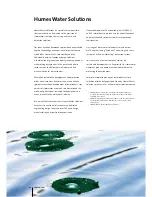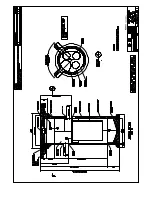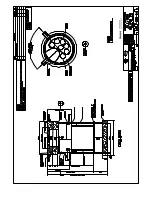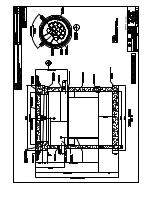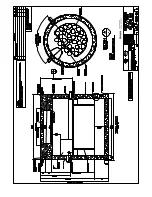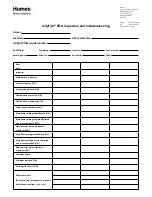
6
JellyFish® filter
Flow into the lower chamber must then pass tangentially
around the separator skirt protecting the cartridges
and increasing the flowpath length. Coarse sediment
settles out of the MAW zone into the sump. As water
flows tangentially around the separator skirt in the
lower chamber, the large opening in the bottom of the
separator skirt and upward change in direction further
reduces flow velocity and enhances particle separation.
As a result, sediment settles in the sump.
Flows pass through the cartridge in the filtration zone.
Each filter cartridge consists of multiple tentacles.
Hydraulic pressure across the entire membrane surface
area causes water to penetrate the filtration tentacles.
Water enters the membrane pores radially and deposits
fine particulates on the exterior membrane surface.
Filtered water flows into the centre drain tube of each
tentacle, the water then flows upward and out the top.
Water exiting the top of the tentacles combines under
the lid, where the combined flow exits the cartridge
through the orifice with a pulsating fountain effect
into the backwash pool. When the water level in the
backwash pool exceeds the weir height it overflows to
the outlet pipe.
Outside the backwash pool, the draindown cartridge
provides treatment at a reduced flow rate (2.5 L/s) and
allows the treated water captured in the backwash pool
to return through the cartridges and balance water
pressure as the storm event ends.
As particles build up on the external membrane
surface, the pores progressively become smaller. This
process, referred to as “filter ripening”, significantly
improves the removal efficiency relative to a brand
new or clean membrane. Filter ripening accounts for
the ability of the JellyFish® filter to remove particles
finer than the nominal pore size (20 microns) rating
of the membranes. An animation of the JellyFish®
filter operation and maintenance is available at
humeswatersolutions.com.au.
Self-cleaning functions
The JellyFish® filter utilises several self-cleaning
processes to remove accumulated sediment from the
external surfaces of the filtration membranes, including
automatic backwash of the high-flow cartridges,
vibrational pulses, and gravity. These processes have
been confirmed by more than 12 months of full
scale prototype testing. Combined, these processes
significantly extend the cartridge life, maintenance
interval and reduce life-cycle costs.
Automatic backwash occurs with the high-flow
cartridges at the end of each runoff event. This can occur
multiple times during a single storm event as intensity
and driving head varies. As the inflow subsides and
driving head decreases, water in the backwash pool
reverses flow direction and automatically backwashes
the high-flow cartridges, removing sediment from the
membrane surfaces. Water in the lower chamber (below
deck) is displaced through the draindown cartridges.
Vibrational pulses occur as a result of complex and
variable pressure and flow direction conditions that
arise in the deck during operation. During forward flow
a stream of filtered water exits the top of each filtration
cartridge and encounters resistance from the turbulent
pool of water in the backwash pool. Water is forced
through the cartridge lid orifice into the backwash pool
with a pulsating fountain effect. The resulting pulses
transmit vibrations through the deck to the membranes,
thereby dislodging accumulated sediment. The effect
is pronounced at higher flow rates, and influences
all cartridges.
Accumulated sediment on the membranes will settle
under gravity both during inflow events and inter-event
dry periods. As fine particles form into larger masses
on the membrane surface, adhesion to the membrane
surface lessens, and sediment sheds away from the
membrane. Chemical processes and biofilm effects also
play a role.


